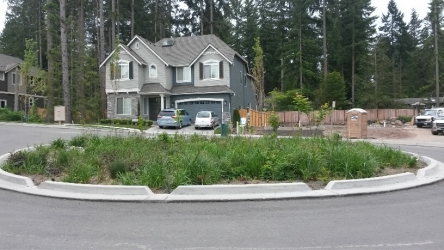2.3
Low impact development (LID) is a stormwater and land use management strategy that strives to minimize pre-disturbance to hydrologic processes of infiltration, filtration, storage, evaporation, and transpiration. In Kitsap County and elsewhere, the terms Green Stormwater Solutions (GSS) or Infrastructure (GSI) are also used to describe LID stormwater management practices. LID/GSS goals are accomplished by emphasizing conservation and use of onsite natural features, site planning, and distributed stormwater management practices that are integrated into a project design. LID/GSS strategies can be applied to new development, urban retrofits, infrastructure improvements, and revitalization projects to protect aquatic resources.
LID/GSS principles and applications present a significant conceptual shift from a purely structural to a primarily source reduction approach. Site planning and stormwater management are integrated at the initial design phases of a project to maintain a more hydrologically functional landscape even in denser settings. Hydrology and natural site features that influence water movement (described above) are used to guide road, structure, and other infrastructure layout. Native soil and vegetation protection areas and landscaping are strategically distributed throughout the project to slow, store, and infiltrate storm flows, and also serve as project amenities.
The goal of LID/GSS is to prevent physical, chemical or biological degradation to streams, lakes, wetlands, and other natural aquatic systems from commercial, residential or industrial development sites. Properly designed LID/GSS measures can reduce stormwater runoff from a project site. As a result, the size and cost of conveyance, flow control, and Runoff Treatment BMPs can be greatly reduced or, in some cases, eliminated. A good description of the LID planning, along with detailed descriptions of LID measures can be found in the LID Technical Guidance Manual.
Photo 1. Bioretention BMP in a LID Residential Neighborhood.
Bioretention BMP in a cul-de-sac of a LID residential neighborhood in construction in western WA. The bioretention manages stormwater runoff from the roadway and contributing roof and driveway areas. Numerous large existing trees were retained, adding valuable stormwater and community benefits.
